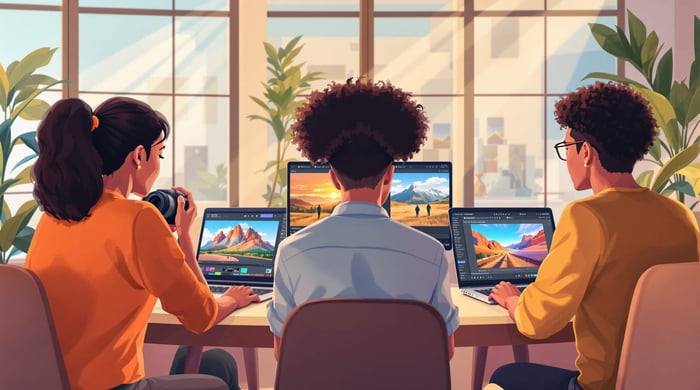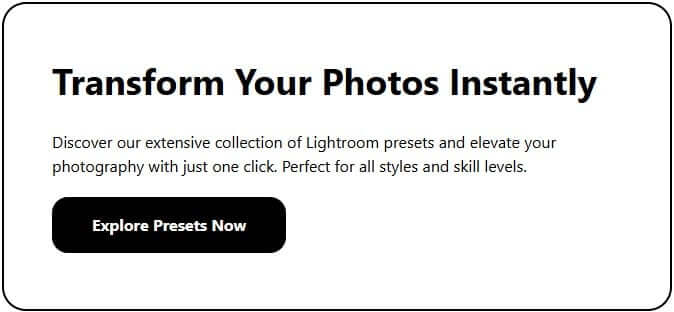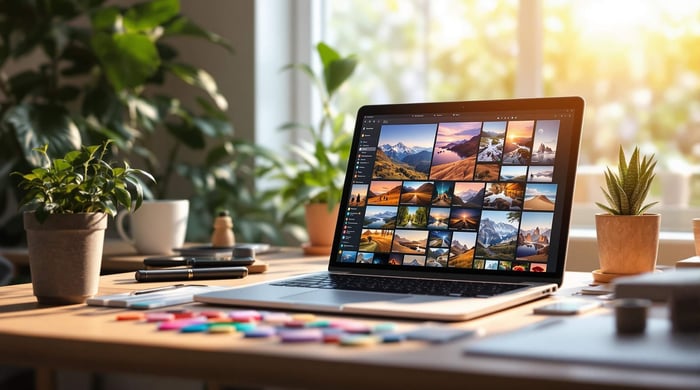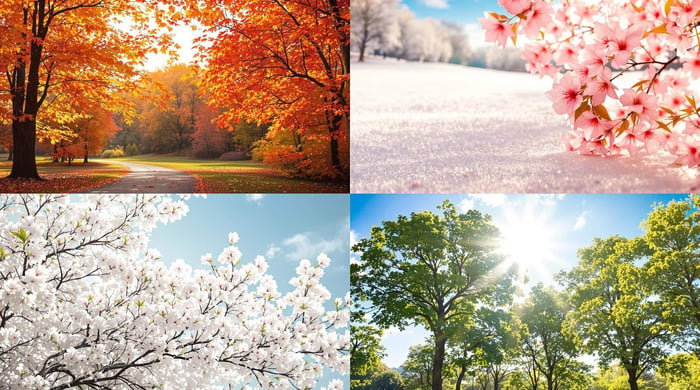How Presets Save Time: Insights From Real Life Photographers
Photo presets are a fast way to edit images by applying pre-configured settings like exposure, contrast, and color grading with one click. They save time, ensure consistency, and simplify workflows for photographers. Here's why they matter:
- Batch Editing: Apply the same edits to multiple photos at once, perfect for large projects like weddings.
- Consistent Style: Maintain a cohesive look across images with minimal effort.
- Learning Tool: Great for beginners to understand editing techniques.
- Quick Adjustments: Fine-tune pre-sets to match specific lighting or scenes.
Presets are a starting point, not a replacement for manual edits. They speed up the process while allowing creative control over individual images.
How Presets Cut Editing Time
Quick Batch Processing
Adobe Lightroom makes editing faster with its batch processing feature. Photographers can apply pre-sets during import to fix common issues like underexposure or dull colors across an entire set of photos instantly [3]. In the Library module, you can select multiple images and apply different pre-sets based on the scene or lighting. Meanwhile, the Develop module's sync feature lets you fine-tune edits across selected images [3][4]. This streamlined process not only saves time but also lays the groundwork for a cohesive style.
Maintaining Style Across Photos
Presets are a great starting point for creating a consistent look across your photos [1]. They provide a base that can be tweaked to match the specific needs of each scene.
"However, by adding a preset to all of the images and only customizing where it's needed, your batch will now have a tonal theme and universal style. Presets set the tone for every image in your batch. There is a standard foundation to follow and presets will tie everything together." – Moment [1]
This method ensures that your photos share a unified aesthetic while still allowing for adjustments to individual images when necessary.
Simplifying Edit Choices
Presets also reduce decision fatigue by automating routine edits. British photographer Andy Day explains:
"In short, presets can give immediate results, but ideally, they should be a tool for learning, not just a means of getting a quick edit to go on your Instagram." – Andy Day [2]
For beginners, pre-sets can be a learning tool, helping them see how different effects are created [2]. By taking care of repetitive tasks, pre-sets free up time and mental energy for more creative decisions, making them especially helpful when working under tight deadlines or with large photo collections [5].
How To Easily Batch Edit in Lightroom Classic
Photographers Share Their Methods
Photographers across various genres use pre-sets to save time and maintain consistency in their work. Here’s how they make it happen:
Wedding Photos: Editing Large Batches
Wedding photographers often need to edit hundreds of photos from a single event while ensuring every image looks polished. Presets simplify this process, especially when lighting conditions (like outdoor, indoor, or golden hour shots) stay consistent. By grouping similar photos together, photographers can apply pre-sets tailored to specific settings, cutting down on editing time without sacrificing quality.
Portrait Work: Creating a Signature Look
For portrait photographers, pre-sets help achieve a consistent, polished style across multiple sessions. These pre-sets fine-tune elements like exposure, contrast, skin tones, and shadow/highlight balance, providing a professional finish. With these adjustments handled automatically, photographers can focus on adding personal touches to their work.
Landscape Photos: Adapting to Light Changes
Landscape photographers deal with constantly shifting lighting, from soft morning hues to harsh midday sun. Presets tailored to different conditions - like soft light, backlighting, or tungsten lighting - help them manage these changes efficiently. By selecting and tweaking the right pre-sets, they can quickly adapt to varying conditions and produce high-quality, consistent results without hours of manual editing.
Making Your Own Presets
Custom presets can save you time and streamline your editing process. Here’s how to create, organize, and refine them step by step.
Building Custom Presets
Start by selecting an image in the Develop Module that represents the style you want. Reset all sliders to their default settings before making adjustments. Focus on applying core settings that will stay consistent across images - skip adjustments like white balance and exposure since they depend on the specific scene.
Organizing Your Presets
Once your preset is ready, organize it for easy access. Professional organizer Samanta Katz shares:
"Organizing your Lightroom presets will help you edit better. Nothing makes creativity flow easier than a clean 'house'." [6]
Here’s how to keep your pre-sets in order:
- Group them based on lighting conditions or photography genres.
- Use clear prefixes in preset names for quick identification.
- Regularly back them up to avoid losing them.
- Remove any pre-sets you no longer use to declutter.
Fine-Tuning Presets for Flexibility
After organizing your pre-sets, tweak them to suit different scenarios. Keep these adjustments in mind:
| Adjustment Type | Best Practice | Why It Matters |
|---|---|---|
| White Balance | Exclude from preset | Changes with lighting conditions |
| Exposure | Adjust manually | Varies for each image |
| Color Grading | Include in preset | Ensures a consistent style |
| Contrast/Clarity | Include in preset | Adds a distinct, polished look |
For advanced users, tools like PixelPeeper let you extract settings from JPG files and save them as XMP presets. This makes it easy to recreate looks from photos that inspire you and incorporate them into your workflow [7].
Tips for Better Preset Results
Presets vs. Manual Edits
Striking the right balance between pre-sets and manual edits can save time while maintaining quality. British photographer Andy Day highlights this balance perfectly:
"If people see the edit before they see the photo, you've gone too far." [2]
Pre-sets are ideal as a starting point, especially when working with a large batch of photos captured under similar conditions. They help create a consistent look quickly. However, pairing pre-sets with manual adjustments is key for fine-tuning individual images.
| Editing Approach | Best Used For |
|---|---|
| Pre-sets | Editing multiple photos with similar settings |
| Manual Edits | Addressing tricky lighting or unique details |
| Combined Approach | Perfect for wedding or event photography collections |
This combination ensures an efficient workflow while maintaining a polished finish. Once you've applied pre-sets, refine your edits with more precise adjustments.
Adding Specific Adjustments
Pre-sets lay the groundwork, but targeted adjustments take your edits to the next level. Focus on these areas to refine your images:
Basic Panel Tweaks
After applying a preset, fine-tune exposure and white balance to ensure the image is properly lit and balanced.Advanced Adjustments
Use tools like the Tone Curve and HSL/Color panels to adjust tones and color ranges for better precision.Local Edits
Selective tools like brushes and gradients help you make detailed changes while maintaining a natural look.
These steps help you achieve a polished result and set the stage for improving your pre-sets over time.
Keeping Presets Current
To keep your workflow effective and aligned with your style, regularly update your pre-sets. Here’s how:
Evaluate and Remove
Periodically review your pre-sets and get rid of ones that no longer match your style.Refresh Frequently
Update your most-used pre-sets to reflect current trends and your evolving preferences.Back Up
Regularly save your pre-sets to avoid losing valuable tools in your workflow.
Start with subtle pre-sets to build your editing skills [2]. Taking breaks during editing can help you assess your work with fresh eyes, ensuring your adjustments enhance the image rather than overpower it. Updating your pre-sets regularly keeps your workflow aligned with your personal style and helps maintain consistency.
Conclusion: Time Saved with Pre-sets
Pre-sets can dramatically streamline editing workflows. A survey from a Facebook photography group found that over 75% of photographers save at least 90 seconds per image when using pre-sets [8]. For large-scale projects like weddings, this can turn days of editing thousands of photos into just a few hours [10].
Photographers also highlight these benefits in their own work. Danielle Joy explains:
"Custom pre-sets allow you to apply your signature style with just one click... This doesn't mean you won't fine-tune individual images, but it provides a strong foundation that saves hours in post-processing." [9]
Presets not only save time but also help maintain a consistent style. Susan Stripling uses custom pre-sets to process hundreds of wedding photos efficiently while keeping her signature look intact [9].
Here’s how pre-sets impact different editing scenarios:
| Editing Scenario | Time Impact with Pre-sets |
|---|---|
| Single Portrait | 90+ seconds saved per image |
| Wedding Album (5,000 photos) | Reduced from days to hours |
| Commercial Series | Instant style consistency |
Chris Daniels sums it up well:
"The ability to quickly edit an entire series of images is the single greatest time-saver while editing." [10]
Beyond speed, pre-sets are invaluable for ensuring consistent results. For example, Karl Taylor uses them in his commercial photography to maintain uniform colors and tones across product shoots - critical for branding [9].



.png)



